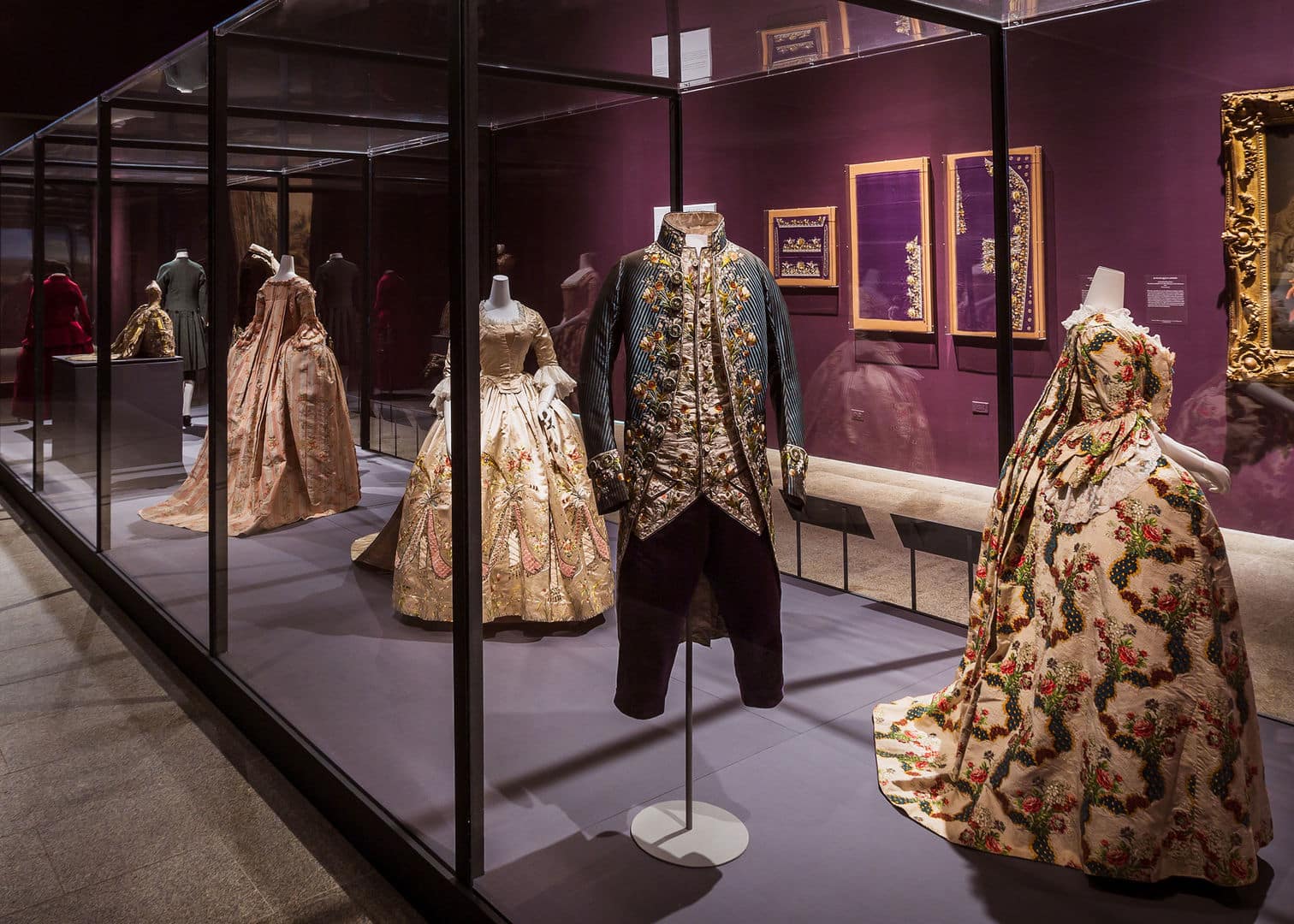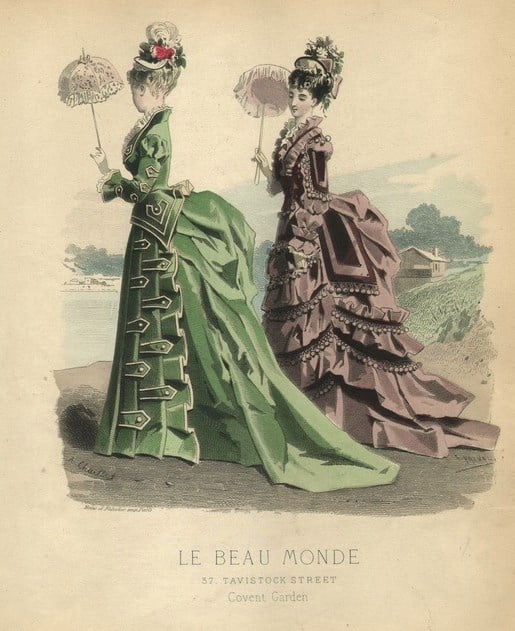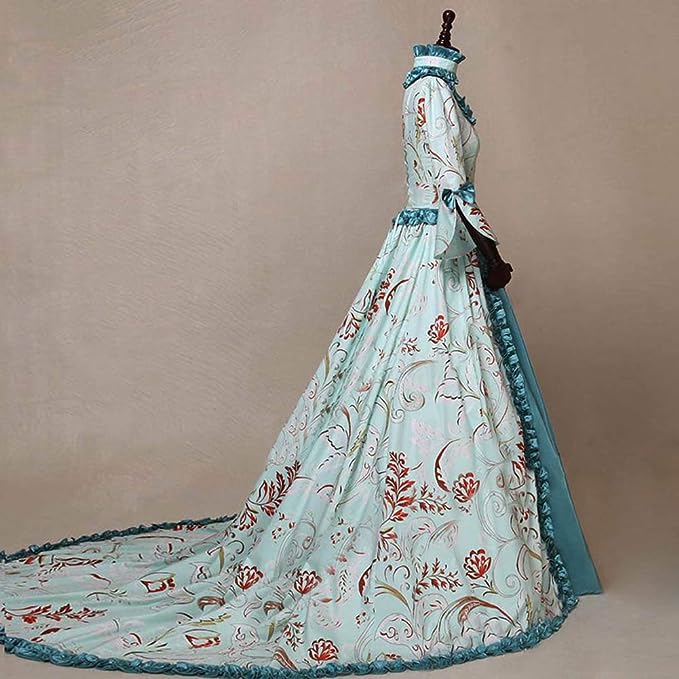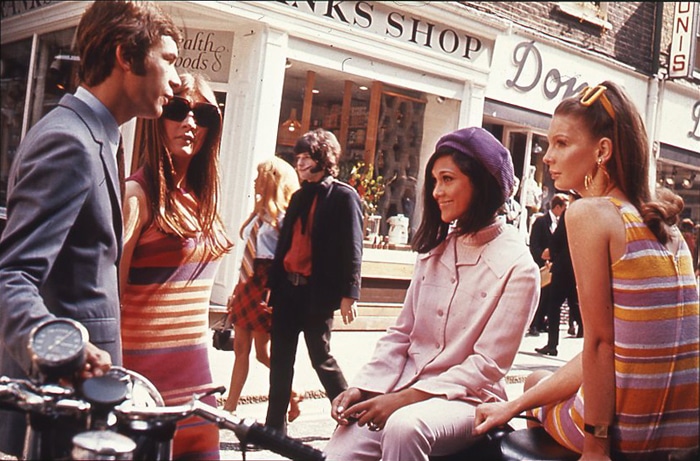Fashion has been a prominent aspect of human culture since ancient times. The way we dress has always been a reflection of our social status, cultural beliefs, and personal style.
Throughout history, fashion has gone through various eras and clothing styles, each with its own unique characteristics and influences.
From the elegant and sophisticated fashion of the Victorian era to the rebellious and edgy styles of the punk movement, fashion has continuously evolved to keep up with the changing times.
Below we're breaking down each fashion era with photos of some iconic outfits as well as products you can purchase to replicate them.
Fashion Eras 1800-2000: Clothing Style Names and Design Era Terminology
We'll be discussing fashion eras from the following time periods:
- 1714 - 1760
- 1800 - 1837
- 1837 - 1913
- 1913 - 1947
- 1947 - 1970
- 1970 - 1985
- 1985 - 2000
- 2000 - Beyond
- Subcultural Styles
Read on for a timeline of fashion eras that will familiarize you with style names, history, and origins.
Georgian Era Fashion (1714-1830)
Fashion in the early Georgian era, from 1714 to 1760, was characterized by a grandiose and formal aesthetic that reflected the opulence of court life and the influence of Baroque and Rococo artistic styles. Under the reigns of George I and George II, elaborate, structured garments were favored by the upper classes, serving as a symbol of status and wealth.
Read: Georgian Era Fashion
1800-1837 Fashion Eras
Late Georgian Era
Although commonly referred to as the Regency period, the years between 1800 and 1837 are actually considered a part of the Georgian era. During this time, King George III suffered from insanity from 1811 until his death in 1820.
His son, who was already serving as Regent, ascended to the throne as King George IV and reigned from 1820 to 1830. He was succeeded by his brother, William IV. However, after his death in 1837, the throne was then taken by Queen Victoria.
See Regency Taste.
Regency Era
Regency Fashion, which was prevalent during the period from 1800 to 1820, drew its inspiration from classical principles and the latest fashion trends of the time.
This style of dress was characterized by elaborate ornamentation and intricate details, reflecting the elegance and sophistication of the era.
Classical Greek Dress
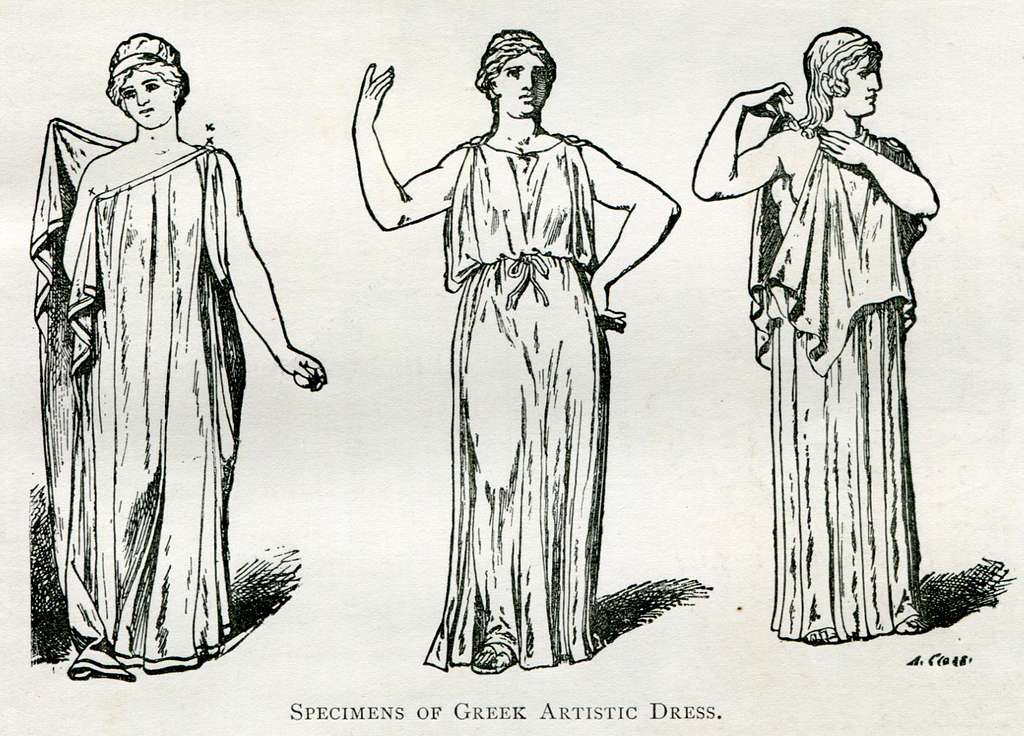
From 1800 to 1803, the prevailing style of dress was classical, featuring ornaments and decorations that were heavily inspired by Greek designs.
This included the use of Greek key borders, which were a popular element in clothing during this time period.
Image courtesy of world4.eu
Etruscan and Egyptian Ornament
During the period spanning from 1804 to 1807, clothing continued to follow classical lines, but with the addition of more exotic ornamentation.
This included elements inspired by Etruscan geometric designs, as well as ornamentation influenced by Egyptian and Asian culture. This era was heavily influenced by the items brought back from the East during Napoleon's expeditions.
Spanish Ornament
Following 1808, Spanish ornamentation began to be incorporated into classical dress styles. This infusion of Spanish influence resulted in a unique and distinctive look, with clothing featuring a blend of classical lines and intricate Spanish-inspired ornamentation.
Gothic Influence
By 1811 Gothic influence crept in debasing the classical lines gradually up until 1820 when the dress lost all classical form and took on a Gothic line.
Romantic Era
The Gothic influence remained during the Romantic Era between 1820 and 1837. This era has a chocolate box image about it, as a military male dress can look very romantic next to a female dress. The romantic spirit in clothes lingered on until 1850 running parallel to the early Victorian Era.
1837-1913 Fashion Eras
Due to its lengthy 64-year duration, the Victorian era cannot be simply defined by the length of one monarch's reign. Instead, in terms of fashion history, the era needs to be subdivided into smaller time periods, each with its own unique characteristics and influences.
This allows for a more nuanced understanding of the evolution of fashion during the Victorian era.
Early Victorian Era
When Queen Victoria was crowned in 1837 the Romantic Era drew to a close. Dress styles between 1837 and 1856 are known as Early Victorian. Sometimes it is also called the Crinoline Era which came about at the time when Charles Worth was making a name for himself as the first modern Couturier.
Mid-Victorian Dress - First Bustle Era
The Mid-Victorian dress period, which spanned from 1860 to 1882, is characterized by its distinct style and design elements. This era is sometimes referred to as the First Bustle Era due to the use of bustles in women's fashion during this time. Bustles were an undergarment designed to create fullness in the back of the skirt, creating a distinct silhouette that was popular during this period.
Bottom left is an example of the First Bustle Era style dresses. On the right is a modern take on the Victorian style dress.
Late Victorian Dress – Second Bustle Era
The Late Victorian era, which spans from 1883 to 1901, saw the emergence of several distinctive fashion trends including the Second Bustle Era, Gibson Girl style, and tailor-made suits for women.
The era was marked by intricate details and embellishments, such as lace, embroidery, and beadwork. Overall, it represents a period of transition and evolution in fashion, reflecting changes in societal norms and values.
Naughty Nineties
Within the late Victorian time frame are secondary periods such as the Naughty Nineties, the final decade of the 19th Century.
The Naughty Nineties was an age of exuberance, casting off the constraints of Victorianism to give way to a more daring fashion sense.
This period saw women wearing trousers in public, decorating their clothing with whimsical motifs such as bugs and flowers, and engaging in outdoor sports like tennis and golf. Hats became popular during this decade
Fin de Siècle
In the last decades of the 19th century from 1870 to 1914 the French were called Fin de Siècle. It culminated in Art Nouveau linear curves in dress, decorative arts, and design. It should not be taken literally as the end of the century. It heralded the mood of change from an old world to a modern era.
Art Nouveau embraced new ideas in changing technology, cultural, social, and political changes, urbanization and a lingering nostalgia for the old and valued. Metaphysical thought implies that the last 25 years of a century heralds a new energy.
La Belle Époque Era
This period from the mid-1890s to 1914 was the era the French called La Belle Époque and J. B. Priestley called the ‘Lost Golden Age’. Although mainly covering the Edwardian Era it puts La Belle Époque into a time capsule.
La Belle Époque captures the mood in that indefinable time of beautiful dress and luxury living for the few in the two decades immediately before the outbreak and devastation created by World War One.
The 20th Century
The 20th century has rarely had the name of the monarch or the name of a royal house lent to any era. There was an attempt in 1953 at the crowning of Queen Elizabeth II and later in 1977 after 25 years of reign to use the term New Elizabethans.
Also, the global nature of communication means that eras are more likely to be named after a war or technological era than a British queen or king as happened when Britain ruled the waves. So in the 20th Century, we heard the terms space age, antibiotic age, technological society, the computer age, the age of Aquarius, the new age, and the communications era.
We began the year 2000 by calling the new era the millennium era, but since the repercussions of Sept 11th, 2001 have caused waves across the world various phrases have been applied such as the freedom age, carpe diem age, or simply after nine eleven. Now we are more happily referring to it as the double-meaning term the noughties.
Art Nouveau Era
Art Nouveau was a decorative art form that followed the Arts and Crafts Movement. It spread throughout Europe and was a dominant art form in 1900 at the Paris Exhibition. It primarily covered interiors, architecture, jewelry, and furniture design.
But its importance filtered through into fashion and fabrics. The long stylized flowers and flowing embroidered borders with trails of organic forms of Art Nouveau are all reflected in the clothes of the Edwardian Hostess.
Their skirts belled out and flowed like blossoming opening floral forms. The embellishment captured the graceful Art Nouveau forms. These fashions in textiles were revived in the 1960s by the House of Liberty.
1913-1947 Fashion Era History Timeline
Asian Influence Era
Asian influence has appeared in and out of fashion history several times, but it is particularly associated with the movement in a dress inspired by artist Léon Bakst the customer and set designer of Sergei Diaghilev’s Ballet Russes in 1909. The dress designers Paul Poiret and Paquin were very influenced by the ballet and separately created garments with oriental influences. Poiret’s designs of 1910-1911 were thought scandalous.
First World War Era
This is the era between 1914 and 1918. It is a period of great change internationally in Europe in particular. It is a time of female emancipation when skirts were first shortened to show calves and more practical clothing emerged as women did war work.
The 1920s: Flappers and Bright Young Things
A flapper was initially a derogatory term but soon was used to describe any young woman of the mid-1920s who wore cloche hats, bobbed her hair, and favored shorter skirts whilst she shimmied the night away dancing the Charleston.
The same mixed partying set was sometimes called Bright Young Things.
Art Deco and the Roaring Twenties
On the left: a photo from a party in the 1920s from OWW media. On the right is a 1920s-inspired costume with accessories that you can purchase online.
Art Deco originated in Europe and became known after the correct name of the 1925 Paris Exhibition. The exhibition was called The Great Exposition Des Arts Modernes Decoratifs Et Industriels. The style was most popular in the Stylish Thirties as well as between 1920 and 1940 by which time it had refined itself.
The artist Erté was a master of Art Deco. The sets and costumes for stage and film that he designed influenced other fashion designers between 1915 and 1936.
Harlem Renaissance fashion
The Harlem Renaissance fashion is typically associated with the period from the 1920s to the early 1930s, coinciding with the broader Harlem Renaissance movement, which celebrated African American cultural, intellectual, and artistic contributions. This era marked a flourishing of Black identity, pride, and creativity, particularly in Harlem, New York.
The Era of Utility Clothing: World War II 1939-1945
This period covers rationed clothes under the Civilian Clothing Utility Scheme particularly in Great Britain during the 1939-1945 World War.
The period extends beyond the war’s end and it is only in the 1950s that austere garments were replaced en masse by a more lavish use of fabrics and full-skirted dresses. Basically, this can be seen as a modern use of the old idea of sumptuary laws.
1947-1970 Fashion Era History Timeline
The New Look Era
After Dior launched his new fashion designs in 1947 Life magazine dubbed it ‘The New Look’. Although dated from the 1940s, it is quite a separate look from the austere military-influenced garments of wartime. The New Look remained fashionable for about 10 years well into the late 1950s. Christian Dior would have been 100 in 2005.
Hollywood Glamour Girls
Hollywood Glamour is a style associated with about 30 years of film from the early 1930s to the late 1950s when the great female stars and studio starlets set the trend in hair, makeup, and clothes in the thirties and 1940s. In the 1950s color films helped fuel the fascination of filmgoers. The stars lived and breathed glamour on and off set.
Below you'll find a photo of Rebel Randall, an American film actress in the 1940s. On the right we found a Hollywood glamour-esque faux mink sole.
After World War II, Hollywood glamour helped define the groomed consistently glamorous look of the 1950s. It is a look that few film stars still manage to pull off continuously. The best survivor of the starlet era for glamour in the 21st century is the actress Joan Collins.
Era of Ready to Wear – Prêt-à-Porter
Mass production improved so much between 1945 and 2000 that the period ever since has been one primarily of ready-to-wear rather than Haute Couture. In France ready to wear is known as Prêt-à-Porter.
The 1950s – Era of Rock and Roll and Teenagers
For the first time ever during the 1950s, fashion was specifically designed for young women and men. It was the first time the word teenager was coined.
The clothing separates that were popular were inspired by American university campus fashions young people wore when jiving and rock and roll dancing. Elvis Presley and James Dean typified the angry young man in the teen uniform of jeans.
Swinging Sixties London: The Era of the Mini Dress
In 1966 Britain earned the label ‘Swinging London’ from Time magazine. Mary Quant exported her youthful short mini dresses to America. In London strings of individual retail outlets followed her, producing clothes for the new teenage mass market.
The photo on the left is A scene from Carnaby Street, in London's West End, c. 1966 from Wikipedia. This era was so iconic that many people reference it for themed parties. On the right is a 60s-inspired outfit you can purchase online.
The mini era of the 1960s was born and taken up by the generation of baby boomers. Because British pop music, in particular, that of the Beatles was also so fashionable worldwide, Britain was seen as having its finger on the pulse and the new mini fashion was all part of that.
Op Art Era
Op Art was a term coined in 1964. Bridget Riley popularised this with optically distorted geometric patterns in black and white producing a whole range of movements on a surface. When applied to the fabric it created a new bold look in fashion and accessories.
Many garments were split into sections with color contrasts after the paintings of Mondrian and this was an important fashion look in the 1960s.
Flower Power Era and Ethnic Folkloric 1960s-Early 1970s
In the USA, by the mid-1960s flowers, clothing, music and freedom protests established an era. Garments from far-flung parts of the middle and far east became the adopted uniform of a generation. From Afghan coats, Romanian and Indian peasant embroidery, cheesecloth, safari and Nehru jackets to Art Nouveau, flower power took hold of hippies or flower children.
Watered-down versions were adapted by Yves St. Laurent and reached the mass market, but they never had the authenticity of the looks individuals produced by fashioning their own ideas. Elements of the ethnic look are also known as the ‘Hippy Era’. This look in various new formats was regurgitated through 2005 as the eclectic ethnic bohemian look.
1970-1985 Fashion Era History Timeline
Disco Fever Mid-1970s
Disco clothes were never for work, but for a weekend of fun, posing, and dancing. Trousers that flared, figure-hugging shaped sharply cut jackets in pastel colors that glowed in the disco light were elevated to new heights by platform shoes.
Silver and shimmering Lycra, sequin boob tubes, and stretch catsuits sum up an era that was set alight by the film ‘Saturday Night Fever’ and the Bee Gees singers.
New Romantics Era 1980s
The New Romantics chose themes from Hollywood, fiction, or history and then adapted it to make a personal look. The look was dramatic, flamboyant, colorful, and very dressed up with great attention paid to detail. The wearers appeared to have made an effort to look sartorially interesting using frills and fabrics associated with historical periods.
A watered down pretty New Romantic look was worn by Diana the Princess of Wales in her early years and she became a fashion leader. The feminine look soon moved into mainstream fashion.
Power Dressing and Yuppies Era 1980s
In the late 1970s, fashion designers showed garments with oversized shoulders and oversized clothes on slender women. John Molloy’s ‘Dress For Success book advised women to dress for success by wearing suits. He advised women to abandon cardigans at all costs, which he maintained was a secretarial look. The recently updated book is now a huge success again.
The then UK Prime Minister, Margaret Thatcher seen on TV news daily, echoed these power dressing ideas in her structured suits, even taking it into wearing structured brocade evening suits rather than flimsy chiffon dresses. Whilst women don’t wear power shoulders as such today many do adopt the formality of the suit for business power dressing.
The wedding dress of Diana Princess of Wales in 1981 sported huge puffed beret sleeves last seen in the 19th century. The television series ‘Dynasty’ also emphasized the shoulder, simply because the star Linda Evans had naturally wide shoulders.
To make her shoulders appear normal every other actor had their garments shoulder padded and designed to appear wider. The very influential ‘Dynasty’ was watched primarily for its fashions by a global audience of over 250 million viewers.
In the 1980s the combination of all these factors led to women wearing clothes with ever-widening shoulders, dressing in the way a man had in order to ascend the corporate promotion ladder. Wide easy-fit shoulder-padded clothes were seen for over ten years and graced everything from the suit to the T-shirt to knitwear.
1985-2000 Fashion Eras History
Grunge
Grunge was based on fashion started by a youth cult in the Pacific North West region of America in the early 1990s. The key to the look was that nothing matched, nothing was coordinated and an item was preferable if old and worn. The point was to look tousled, uncombed and unkempt as if not too much effort had been made. Many consumers thought it pointless.
Actresses like Julia Roberts who adopted the look were heavily criticized for their lack of glamour. Only those under 21 could get away with this look and Grunge died within a year but left the fashion term. It is frequently used now to describe unattractive fashion features or unkempt individuals.
Deconstructionism
Deconstructionism questions the rules and breaks conventions in fashion. It includes putting seams and zips on the outside of a garment showing the inner construction workings of tailoring that in the past were the hidden features. It recycles old fashion and makes the undesirable part of the dress such as a laddered stocking a desirable feature.
Hussein Chalayan, Martin Margiela and Comme des Garçons are all deconstructionists, but Zandra Rhodes first did this 25 years ago when she put huge pinked sig zag seams on the outside of wool coats.
Minimalism
Minimalism describes pared-down clothes in neutral tones in clean and sculptural shapes Quality fabrics in solid neutrals, with minimal detailing were first seen as a reaction to the glitz and glamour of 1980s styles. It became more popular in the 1990s.
It is functional, urban subdued understated clothing which is never out of date.
Purism
Purism uses neutral tints and shades associated with white, grey, and beige. It is an expensive, quiet, unobtrusive uncomplicated look based on a good cut. It lacks superfluous embellishment in its pure uncluttered simplicity.
It is easy to wear and never feels out of place because it consists of simple functional items that are reduced to the basic elements of elegantly cut modern classics. It uses virtually no jewelry to accessorize the look. The designers Jil Sander, Donna Karan, Giorgio Armani, and Calvin Klein all strive to produce modern classics within the framework of pure functional natural simplicity.
Boho Hippy
The boho hippy era emerged in the 1990s and is a pretty millennium version of the hippy look of the 1960s and 70s. Fashion Designers such as Ghost and Tom Ford have developed variations of the look putting together dreamy velvet trimmed, beaded, and embroidered items.
The early look mainly started by Ghost used lots of chiffons, bias-cut cowl dresses, and soft floating fabrics often teamed with little velvet-trimmed cashmere cardigans. Ford’s later versions used lots of braids, beads, and embroidery, crunchy toning lace, fringe, fur, patchwork, and animal prints.
Embroidery especially is often an embellishment on garments from peasant style to glamorous evening dress. It is in total contrast to the minimal style.
By 2002 it was featured heavily by many other designers on most catwalks east and west. 2005 was the summer of the Boho gypsy-tiered peasant skirt This fashion look was global and by autumn 2005 elements had morphed into the Russian look modifying Boho into eclectic ethnic.
Update – On February 1st, 2002 Voyage the shopfront for Ghost went into liquidation to the tune of £3 million.
At the time fashion journalists slated the once revered company for their former outrageous prices, arrogant attitude to customers, and pompous self-promotion in glossy advertisements. Journalists declared they had never liked the items designed by Ghost and that it never had been real couture.
Laver’s Law is at work here. Ghost as a fashion label is still designed by originator Tanya Sarne who has a stake in the business that was sold. Now Ghost clothes are still sold in concessions and in small boutiques where discerning women shoppers seek clothes that transcend fashion fads.
Many who are looking for something different are often pleased by the washability factor of very special-looking clothes including luxury trousers, tops, and oriental-inspired jackets made from washable silk.
Fashion Subcultural Styles
Subcultural styles first developed around the 1940s.
Subcultural styles were identified in a book called Surfers Soulies Skinheads and Skaters – Subcultural Style From the Forties to the Nineties written by Amy de la Haye and Cathie Dingwall, with photography by Daniel McGrath.
The book was written as a supporting document for a Victoria and Albert Museum fashion exhibition called Streetstyle Exhibition shown in November 1994.
Subcultural street styles include Afrocentric, B-Boy, Beatnik, Bhangra, Caribbean, Casuals, Cowboy, Cyberpunk, Eco, Fetish, Funk, Gay style, Glam rock, Greasers, Grunge, Head-Bangers, Hippy, Hipsters, Indie, Jungle, Madchester, Mod, New Age, Northern Soul, Old Skool, Preppy, Psychedelic, Psychobilly, Punk, Ragga, Rasta, Rave, Rude Boy, Skater, Skinhead, Soulies, Streestyle, Surfer, Techno, Teddy Boys (Teds), Travellers, Two Tones, Workwear Rockabilly, Yardies, Young British Radicals and Zoots.
I suggest that if you have an interest in any of the street styles listed above you obtain the illustrated and informative book.
There is also plenty of information on the internet about the culture and clothing of hip-hop for those interested in that area of fashion. One interesting point is how some of the styles have been picked up by designers, adapted and invaded the catwalks so that we now see many of these once-original and styles as high fashion innovations in mainstream clothing.
Once again another aspect of my page Laver’s Law is at work here. If you want to know more, the book is called Surfers Soulies Skinheads and Skaters: Subcultural Style from the Forties to the Nineties You may also be interested in the page Laver’s Law a timeline of fashion style by James Laver.
Fashion History and Costume History Sources of Information, Museums, Galleries and Paintings - Typical Costume Evidence
Dress has so fascinated society that a number of records are available to us such as this fashion plate from La Mode Illustrée. These records are either visual representations or written commentary.
On this page are the possible starting points for your research. Combine this with a look at the section on paintings and the bibliography.
National Sources
Museum collections of major national museums and private institutions show actual costume and accessories. In the UK the Victoria and Albert Museum in Kensington, London is one of the prime sources of costume. The other great costume collection is held at the Costume Gallery in Bath, in the West of England. Both venues house superb collections of costumes.
In Bath, the Costume Gallery provides individual audio controls with up to 6 language translations. The costume displayed is only one-quarter of the actual costume available and it is all used in regularly rotated displays.
Additionally, the Research Centre at Bath connected to Bath Museum Educational services has wonderful resource material such as original C19th accessories as well as published material such as La Belle Assemblee , Moniteur de la Mode, Englishwoman's Domestic Magazine, Le Petit Courrier des Dames, Le Follet, Godeys, The Queen and Chic Parisian. In addition, they hold many fashion catalogs of the C20th.
Prior to the medieval era those seriously researching costume details, need to resort to written sources. These are often difficult to use and are usually in Latin or medieval English. For example, many royal household accounts have never been translated into modern-day English. They do not always translate well as they were often written by monks and other educated clergy. Sometimes the references to clothing are lost in the translation.
Until the 16th century, most evidence is taken from the following:-
Metalwork
Stonework
Sculpture
Mosaics
Woodcarvings
Sketches
Ceramics
Paintings
Embroideries
Tombs
Weavings
Stumpwork
Body Jewellery
Cave Drawings
Brass Rubbings
Cave Drawings
Actual Costume Artefacts
Few artifacts before 1600 AD have survived. Those that have, were usually found in extreme environmental conditions where either intense cold or dryness preserved articles. Such items have been found in freezing areas of Russia or the contrasting dry sands of Egypt. Sometimes jewelry or hard body equipment such as ivory beads and armory survive, whilst the surrounding fabric may have disintegrated.
Costume Plates and Fashion Plates
From the 16th century, costume plates appeared.
It is important to understand that costume plates represent fashion as it was worn.
In contrast, fashion plates like pre 20th century fashion dolls promote and publicize possible future fashions.
It is still possible to collect good costume and fashion plates in antique shops and at auction sites. Prices vary and are dependant on the quality and rare value of the print. As an example I paid £12.50 in 2002 for the page of 8 illustrated mantles.
One of the easiest ways to see fashion plates is by visiting a museum site or commercial site that sells them on the internet.
For the collector who is interested in a particular era and maybe who just wants to enliven their decor with a set of fashion plates then there are great reproductions of fashion plates on the market.
Some of the most attractive examples of reproduction print fashion plates I have seen are for sale at alldressforms.com and some examples are shown below.
Late Victorian Dress
The two late Victorian pictures above are of fashion plate reproductions of the originals found in La Mode Illustrée and sold by alldressforms.com in their fashion Art section.
Fashion Dolls
Fashion Dolls date from as early as the 14th century. They were widely used in the 17th and 18th centuries as a primary means for supplying the last word in:-
- Fashion
- Hairstyles
- Millinery
Paintings
In the UK visit the National Gallery, Country Houses and Galleries.
Written Costume and Fashion Information
Visual representations of dress need to be cross-checked with other information. The problem of artistic license has always existed and even the photographs available after Kodak's camera invention of 1888, are not always a true record.
Written references:-
- Essays
- Satires
- Biographies
- Contemporary Novels
- Memoirs
- Historical Works
- Philosophy Books
- Etiquette Manuals
- Personal Conduct Manuals
- Records
- Newspapers
- Magazines
- Posters
- Event Programmes
- Accounts of Travel and Exploration
- Religious Manuals (often a very rich source of information on dress)
- Diaries e.g. those of Queen Victoria, Jane Austen, and Samuel Pepys.
Where legend and fact have blended all can play a part in validating the authenticity of representation.
Exhibitions
Exhibition Catalogues such as those from the Great Exhibition of 1851 give facts that are frequently illuminating. Auction houses produce catalogues and Sotheby’s and Christies have catalogs with detailed information of sales collections such as Wallis Simpson’s jewelry and the sale of the clothes of the late Princess of Wales, Diana.
Trade Cards and Advertisements
There are collections of trade cards and advertisements in national and local collections. Companies, especially long-established ones, often have a written history or records that they will allow the public to access. Old catalogs of shops such as that of Sears or Harrods or Selfridges are a rich source of information.
Cartoons
In addition, cartoons, especially those by Punch magazine, can encapsulate fashion or current ideals of modesty or immodesty. Similarly, moral writers of today still describe fashion as right or wrong just as writers of 1000 years ago did.
Local Sources
Public libraries, museums, galleries and private collections may contain family records with account books and local business archives. Newspapers both local and national have always carried articles on fashion and the materials used in fashionable dress. Centenary celebrations and the like sometimes reveal huge collections of photographs that someone found in an attic.
By its very nature this information is constantly changing, but some of my favourite museums of costume are below.
There are also other collections in the UK too many to mention, but some of my favorites that I have personally visited and always enjoy are:-
The Costume Collection in central Nottingham.
The Potteries Museum and Art Gallery in Hanley, Stoke on Trent where you can compare ceramics of the era.
The Museum Of Childhood in Bethnal Green (Wedding Dresses/Doll’s Houses)
Platt Hall in Manchester
Christchurch (near Bournemouth) Costume Museum
The Museum Of Welsh Life at St. Fagans - Folk Museum just outside Cardiff
The information on this page is constantly changing and may be withdrawn at any time. Fashion-Era.com can take no responsibility for any loss you may incur as a result of using the information here.
